Regulation of synapse structure and function by distinct myosin II motors
- PMID: 21273429
- PMCID: PMC3074980
- DOI: 10.1523/JNEUROSCI.3294-10.2011
Regulation of synapse structure and function by distinct myosin II motors
Abstract
Ongoing synaptic function and rapid, bidirectional plasticity are both controlled by regulatory mechanisms within dendritic spines. Spine actin dynamics maintain synapse structure and function, and cytoskeletal rearrangements in these structures trigger structural and functional plasticity. Therefore, proteins that interact with actin filaments are attractive candidates to regulate synaptic actin dynamics and, thus, synapse structure and function. Here, we have cloned the rat isoform of class II myosin heavy chain MyH7B in brain. Unexpectedly, this isoform resembles muscle-type myosin II rather than the ubiquitously expressed nonmuscle myosin II isoforms, suggesting that a rich functional diversity of myosin II motors may exist in neurons. Indeed, reducing the expression of MyH7B in mature neurons caused profound alterations to dendritic spine structure and excitatory synaptic strength. Structurally, dendritic spines had large, irregularly shaped heads that contained many filopodia-like protrusions. Neurons with reduced MyH7B expression also had impaired miniature EPSC amplitudes accompanied by a decrease in synaptic AMPA receptors, which was linked to alterations of the actin cytoskeleton. MyH7B-mediated control over spine morphology and synaptic strength was distinct from that of a nonmuscle myosin, myosin IIb. Interestingly, when myosin IIb expression and MyH7B expression were simultaneously knocked-down in neurons, a third, more pronounced phenotype emerged. Together, our data provide evidence that distinct myosin II isoforms work together to regulate synapse structure and function in cultured hippocampal neurons. Thus, myosin II motor activity is emerging as a broad regulatory mechanism for control over complex actin networks within dendritic spines.
Figures

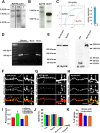
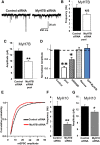
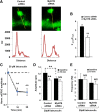
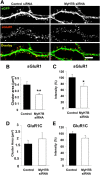
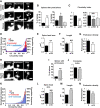

Similar articles
-
Myosin motors at neuronal synapses: drivers of membrane transport and actin dynamics.Nat Rev Neurosci. 2013 Apr;14(4):233-47. doi: 10.1038/nrn3445. Epub 2013 Mar 13. Nat Rev Neurosci. 2013. PMID: 23481482 Review.
-
Myosin IIb regulates actin dynamics during synaptic plasticity and memory formation.Neuron. 2010 Aug 26;67(4):603-17. doi: 10.1016/j.neuron.2010.07.016. Neuron. 2010. PMID: 20797537 Free PMC article.
-
The Arp2/3 Complex Is Essential for Distinct Stages of Spine Synapse Maturation, Including Synapse Unsilencing.J Neurosci. 2016 Sep 14;36(37):9696-709. doi: 10.1523/JNEUROSCI.0876-16.2016. J Neurosci. 2016. PMID: 27629719 Free PMC article.
-
Myosin IIb controls actin dynamics underlying the dendritic spine maturation.Mol Cell Neurosci. 2014 Jul;61:56-64. doi: 10.1016/j.mcn.2014.05.008. Epub 2014 Jun 3. Mol Cell Neurosci. 2014. PMID: 24938665
-
Structural modulation of dendritic spines during synaptic plasticity.Neuroscientist. 2012 Aug;18(4):326-41. doi: 10.1177/1073858411407206. Epub 2011 Jun 13. Neuroscientist. 2012. PMID: 21670426 Review.
Cited by
-
Input-specific regulation of hippocampal circuit maturation by non-muscle myosin IIB.J Neurochem. 2015 Aug;134(3):429-44. doi: 10.1111/jnc.13146. Epub 2015 May 29. J Neurochem. 2015. PMID: 25931194 Free PMC article.
-
Myosin XVI Regulates Actin Cytoskeleton Dynamics in Dendritic Spines of Purkinje Cells and Affects Presynaptic Organization.Front Cell Neurosci. 2019 Aug 13;13:330. doi: 10.3389/fncel.2019.00330. eCollection 2019. Front Cell Neurosci. 2019. PMID: 31474830 Free PMC article.
-
Hippocampal rejuvenation by a single intracerebral injection of one-carbon metabolites in C57BL6 old wild-type mice.Aging Cell. 2025 Jan;24(1):e14365. doi: 10.1111/acel.14365. Epub 2024 Oct 8. Aging Cell. 2025. PMID: 39380362 Free PMC article.
-
Early de novo DNA methylation and prolonged demethylation in the muscle lineage.Epigenetics. 2013 Mar;8(3):317-32. doi: 10.4161/epi.23989. Epub 2013 Feb 15. Epigenetics. 2013. PMID: 23417056 Free PMC article.
-
Myosin motors at neuronal synapses: drivers of membrane transport and actin dynamics.Nat Rev Neurosci. 2013 Apr;14(4):233-47. doi: 10.1038/nrn3445. Epub 2013 Mar 13. Nat Rev Neurosci. 2013. PMID: 23481482 Review.
References
-
- Amaral DG, Dent JA. Development of the mossy fibers of the dentate gyrus: I. A light and electron microscopic study of the mossy fibers and their expansions. J Comp Neurol. 1981;195:51–86. - PubMed
-
- Cheng XT, Hayashi K, Shirao T. Non-muscle myosin IIB-like immunoreactivity is present at the drebrin-binding cytoskeleton in neurons. Neurosci Res. 2000;36:167–173. - PubMed
Publication types
MeSH terms
Substances
Grants and funding
LinkOut - more resources
Full Text Sources
Other Literature Sources
